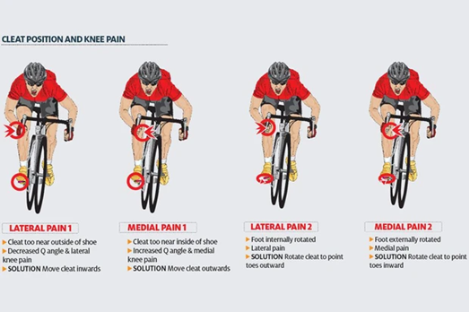By Marie Serrado
Most Cyclists- from beginners to pros will experience some form of knee pain during their riding career. Knee pain is a common complaint among cyclists, both beginners and seasoned riders alike. Whether you’re a road cyclist, mountain biker, or a casual rider, the repetitive motion of pedaling can take a toll on your knees. In this blog, we’ll explore the causes of knee pain in cyclists.
The Four Main Areas in Knee Pain for Cyclists:
The four areas of knee pain are Anterior, Posterior, Medial/Lateral and Iliotibial Band Syndrome.
One prevalent type of knee pain is categorized as Anterior knee pain, which signifies discomfort situated at the front of the knee joint. Anterior knee pain is often localized in the region surrounding the patella, commonly known as the kneecap. This particular area of knee pain is frequently encountered in cycling enthusiasts, mainly due to the repetitive stress and overuse injuries associated with pedaling. According to bikeradar “The large quadricep muscles attach to the shin bone via the patella, so the forces of pedaling are transmitted across the patello-femoral joint whenever we bend our knees, essentially squashing it back against the thigh bone.” This means that during pedaling, the powerful quadriceps muscles, anchored by the patella, convey the forces across the patellofemoral joint as our knees flex, effectively compressing it against the thigh bone.
Now, there are some ways to help treat Anterior knee pain to help reduce the forces through the patella-femoral joint:
-
- Try to keep your leg straight
- Be sure you’re not experiencing bike problems:
With this make sure your saddle is at an appropriate height, pushing too big on the gear or using excessive cranks can also be a problem. - Build up the vastus medialis oblique muscle:
After a week or so of regular stretching and self-massage, work on building up the vastus medialis oblique muscle to balance out the stabilizing forces on the patella. - Dont tape up the patella
Posterior Knee Pain:
When it comes to posterior knee pain ( which is pain in the back of the knee) it’s usually less common. This pain is almost always due to overextending the knee. A bike specific problem to look for is when your saddle is either too high or too far back as this can cause pain further up the hamstring.
Medial and Lateral Knee Pain:
When you experience pain in this region which is pain in the sides of the knee that is usually because of your feet. More specifically, incorrectly fitted pedal cleats. Pedal Cleats are small metal or plastic attachments that are attached to the sole of a cycling shoe. They are designed to clip into the pedals of a bicycle, providing a secure connection between the cyclist and the bike. The blame for these types of pain during cycling is badly placed cleats will affect the Q angle ( which is how far apart your feet are positioned.) or it causes excessive rotation to the knee joints.
Two ways to avoid this pain:
One way is to Check cleats for excessive wear regularly. The second way is to get into a good starting position. Make sure your sitting at the edge of the saddle.

Prevention and Treatments:
Some treatments that you can do for knee pain when it comes to cycling is:
-
- Rest: Do not add weight to your knee
- Ice
- Compression
- Elevation
Now, your doctor may prescribe you an anti-inflammatory drug which will help with the swelling and inflammation of the knee pain.
-
-
If those treatments don’t help with your knee pain, you may need to go seek help from a physical therapist. Some signs that you need to seek a physical therapist is:
- The knee looks off center and has lumps.
- The knee is dislocated.
- You can’t put weight on your knee.
- The symptoms have not improved within a few days.
- The knee joint cant move properly.
-
-
Some ways in order to prevent knee pain or knee injury, would be to:
- Adjust the saddle-pedal distance on their bicycle.
- Wear appropriate shoes for cycling.
- Maintain a moderate weight.
- Warm up thoroughly before cycling.
Conclusion:
In conclusion, addressing knee pain among cyclists is crucial for maintaining a healthy and enjoyable riding experience. Cyclists should prioritize proper bike setup, including saddle height and position, to ensure optimal alignment and reduce strain on the knees. Listening to the body and promptly addressing any signs of discomfort or pain is vital. Cyclists should consult with healthcare professionals, such as physiotherapists or sports medicine specialists, to identify the root cause of knee pain and receive personalized advice on rehabilitation exercises and preventive measures.
References:
- Arthurs-Brennan, Michelle. “Knee Pain from Cycling: Tips on How to Fix It, from a Bike Fitter and Osteopath.” Cyclingweekly.Com, Cycling Weekly, 31 Dec. 2022, www.cyclingweekly.com/fitness/cycling-knee-pain-everything-you-need-to-know-329957.
- BikeRadar. “Why Do My Knees Hurt? Cycling Knee Pain Explained and How to Manage It.” BikeRadar, 16 July 2022, www.bikeradar.com/advice/fitness-and-training/cycling-knee-pain-the-problem-areas/.




